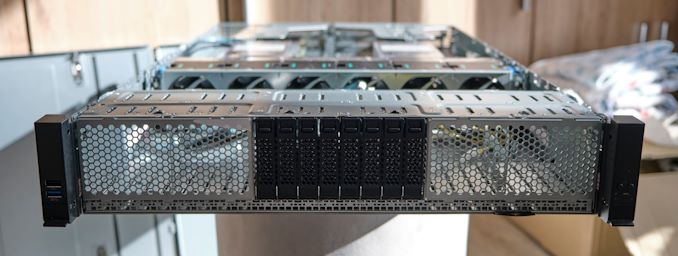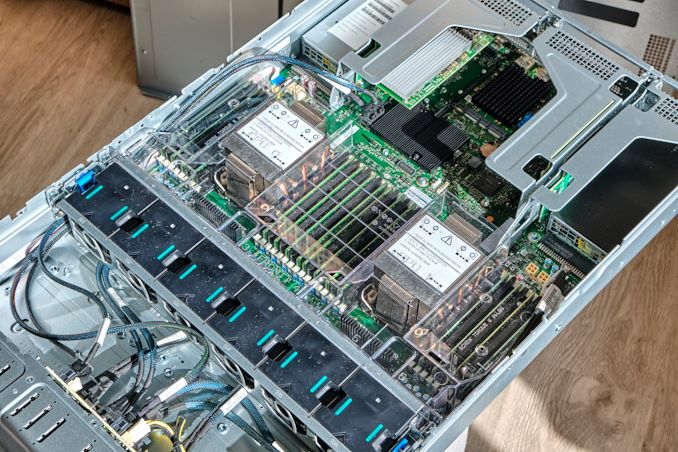Intel 3rd Gen Xeon Scalable (Ice Lake SP) Review: Generationally Big, Competitively Small
by Andrei Frumusanu on April 6, 2021 11:00 AM EST- Posted in
- Servers
- CPUs
- Intel
- Xeon
- Enterprise
- Xeon Scalable
- Ice Lake-SP
Test Bed and Setup - Compiler Options
For the rest of our performance testing, we’re disclosing the details of the various test setups:
Intel - Dual Xeon Platinum 8380
For our new Ice Lake test system based on the Whiskey Lake platform, we’re using Intel’s SDP (Software Development Platform 2SW3SIL4Q, featuring a 2-socket Intel server board (Coyote Pass).
The system is an airflow optimised 2U rack unit with otherwise little fanfare.
Our review setup solely includes the new Intel Xeon 8380 with 40 cores, 2.3GHz base clock, 3.0GHz all-core boost, and 3.4GHz peak single core boost. That’s unusual about this part as noted in the intro, it’s running at a default 205W TDP which is above what we’ve seen from previous generation non-specialised Intel SKUs.
| CPU | 2x Intel Xeon Platinum 8380 (2.3-3.4 GHz, 40c, 60MB L3, 270W) |
| RAM | 512 GB (16x32 GB) SK Hynix DDR4-3200 |
| Internal Disks | Intel SSD P5510 7.68TB |
| Motherboard | Intel Coyote Pass (Server System S2W3SIL4Q) |
| PSU | 2x Platinum 2100W |
The system came with several SSDs including Optane SSD P5800X’s, however we ran our test suite on the P5510 – not that we’re I/O affected in our current benchmarks anyhow.
As per Intel guidance, we’re using the latest BIOS available with the 270 release microcode update.
Intel - Dual Xeon Platinum 8280
For the older Cascade Lake Intel system we’re also using a test-bench setup with the same SSD and OS image as on the EPYC 7742 system.
Because the Xeons only have 6-channel memory, their maximum capacity is limited to 384GB of the same Micron memory, running at a default 2933MHz to remain in-spec with the processor’s capabilities.
| CPU | 2x Intel Xeon Platinum 8280 (2.7-4.0 GHz, 28c, 38.5MB L3, 205W) |
| RAM | 384 GB (12x32 GB) Micron DDR4-3200 (Running at 2933MHz) |
| Internal Disks | Crucial MX300 1TB |
| Motherboard | ASRock EP2C621D12 WS |
| PSU | EVGA 1600 T2 (1600W) |
The Xeon system was similarly run on BIOS defaults on an ASRock EP2C621D12 WS with the latest firmware available.
AMD - Dual EPYC 7763 / 7713 / 75F3 / 7662
In terms of testing the new EPYC 7003 series CPUs, unfortunately due to our malfunctioning Daytona server, we weren’t able to get first-hand experience with the hardware. AMD graciously gave us remote access to one of their server clusters – we had full controls of the system in terms of BMC as well as BIOS settings.
| CPU | 2x AMD EPYC 7763 (2.45-3.500 GHz, 64c, 256 MB L3, 280W) / 2x AMD EPYC 7713 (2.00-3.365 GHz, 64c, 256 MB L3, 225W) / 2x AMD EPYC 75F3 (3.20-4.000 GHz, 32c, 256 MB L3, 280W) / 2x AMD EPYC 7662 (2.00-3.300 GHz, 64c, 256 MB L3, 225W) |
| RAM | 512 GB (16x32 GB) Micron DDR4-3200 |
| Internal Disks | Varying |
| Motherboard | Daytona reference board: S5BQ |
| PSU | PWS-1200 |
Software wise, we ran Ubuntu 20.10 images with the latest release 5.11 Linux kernel. Performance settings both on the OS as well on the BIOS were left to default settings, including such things as a regular Schedutil based frequency governor and the CPUs running performance determinism mode at their respective default TDPs unless otherwise indicated.
AMD - Dual EPYC 7742
Our local AMD EPYC 7742 system, due to the aforementioned issues with the Daytona hardware, is running on a SuperMicro H11DSI Rev 2.0.
| CPU | 2x AMD EPYC 7742 (2.25-3.4 GHz, 64c, 256 MB L3, 225W) |
| RAM | 512 GB (16x32 GB) Micron DDR4-3200 |
| Internal Disks | Crucial MX300 1TB |
| Motherboard | SuperMicro H11DSI0 |
| PSU | EVGA 1600 T2 (1600W) |
As an operating system we’re using Ubuntu 20.10 with no further optimisations. In terms of BIOS settings we’re using complete defaults, including retaining the default 225W TDP of the EPYC 7742’s, as well as leaving further CPU configurables to auto, except of NPS settings where it’s we explicitly state the configuration in the results.
The system has all relevant security mitigations activated against speculative store bypass and Spectre variants.
Ampere "Mount Jade" - Dual Altra Q80-33
The Ampere Altra system we’re using the provided Mount Jade server as configured by Ampere. The system features 2 Altra Q80-33 processors within the Mount Jade DVT motherboard from Ampere.
In terms of memory, we’re using the bundled 16 DIMMs of 32GB of Samsung DDR4-3200 for a total of 512GB, 256GB per socket.
| CPU | 2x Ampere Altra Q80-33 (3.3 GHz, 80c, 32 MB L3, 250W) |
| RAM | 512 GB (16x32 GB) Samsung DDR4-3200 |
| Internal Disks | Samsung MZ-QLB960NE 960GB Samsung MZ-1LB960NE 960GB |
| Motherboard | Mount Jade DVT Reference Motherboard |
| PSU | 2000W (94%) |
The system came preinstalled with CentOS 8 and we continued usage of that OS. It’s to be noted that the server is naturally Arm SBSA compatible and thus you can run any kind of Linux distribution on it.
The only other note to make of the system is that the OS is running with 64KB pages rather than the usual 4KB pages – this either can be seen as a testing discrepancy or an advantage on the part of the Arm system given that the next page size step for x86 systems is 2MB – which isn’t feasible for general use-case testing and something deployments would have to decide to explicitly enable.
The system has all relevant security mitigations activated, including SSBS (Speculative Store Bypass Safe) against Spectre variants.
The system has all relevant security mitigations activated against the various vulnerabilities.
Compiler Setup
For compiled tests, we’re using the release version of GCC 10.2. The toolchain was compiled from scratch on both the x86 systems as well as the Altra system. We’re using shared binaries with the system’s libc libraries.












169 Comments
View All Comments
mode_13h - Thursday, April 8, 2021 - link
Please tell me you did this test with an ICC released only a couple years ago, or else I feel embarrassed for you polluting this discussion with such irrelevant facts.Oxford Guy - Sunday, April 11, 2021 - link
It wasn't that long ago.If you want to increase the signal to noise ratio you should post something substantive.
For instance, if you think think ICC no longer produces faster Blender builds why not post some evidence to that effect?
eastcoast_pete - Tuesday, April 6, 2021 - link
This Xeon generation exists primarily because Intel had to come through and deliver something in 10 nm, after announcing the heck out of it for years. As an actual processor, they are not bad as far as Xeons are concerned, but clearly inferior to AMD's current EPYC line, especially on price/performance. Plus, we and the world know that the real update is around the corner within a year: Sapphire Rapids. That one promises a lot of performance uplift, not the least by having PCI-5 and at least the option of directly linked HBM for RAM. Lastly, if Intel would have managed to make this line compatible with the older socket (it's not), one could at least have used these Ice Lake Xeons to update Cooper Lake systems via a CPU swap. As it stands, I don't quite see the value proposition, unless you're in an Intel shop and need capacity very badly right now.Limadanilo2022 - Tuesday, April 6, 2021 - link
Agreed. Both Ice Lake and Rocket lake are just placeholders to try to make something before the real improvement comes with Saphire rapids and Alder Make respectively... I'm one that says that AMD really needs the competition right now to not get sloppy and become "2017-2020 Intel". I want to see both competing hard in the next years aheaddrothgery - Wednesday, April 7, 2021 - link
Rocket Lake is a stopgap. Ice Lake (and Ice Lake SP) were just late; they would have been unquestioned market leaders if launched on time and even now mostly just run into problems when the competition is throwing way more cores at the problem.AdrianBc - Wednesday, April 7, 2021 - link
No, Ice Lake Server cores have a much lower clock frequency and a much smaller L3 cache than Epyc 7xx3, so they are much slower core per core than AMD Milan for any general purpose application, e.g. software compilation.The Ice Lake Server cores have a double number of floating-point multipliers that can be used by AVX-512 programs, so they are faster (despite their clock frequency deficit) for the applications that are limited by FP multiplication throughput or that can use other special AVX-512 features, e.g. the instructions useful for machine learning.
Oxford Guy - Wednesday, April 7, 2021 - link
'limited by FP multiplication throughput or that can use other special AVX-512 features, e.g. the instructions useful for machine learning.'How do they compare with Power?
How do they compare with GPUs? (I realize that a GPU is very good at a much more limited palette of work types versus a general-purpose CPU. However... how much overlap there is between a GPU and AVX-512 is something at least non-experts will wonder about.)
AdrianBc - Thursday, April 8, 2021 - link
The best GPUs from NVIDIA and AMD can provide between 3 and 4 times more performance per watt than the best Intel Xeons with AVX-512.However most GPUs are usable only in applications where low precision is appropriate, i.e. graphics and machine learning.
The few GPUs that can be used for applications that need higher precision (e.g. NVIDIA A100 or Radeon Instinct) are extremely expensive, much more than Xeons or Epycs, and individuals or small businesses have very little chances to be able to buy them.
mode_13h - Friday, April 9, 2021 - link
Please re-check the price list. The top-end A100 does sell for a bit more than the $8K list price of the top Xeon and EPYC, however MI100 seems to be pretty close. perf/$ is still wildly in favor of GPUs.Unfortunately, if you're only looking at the GPUs' ordinary compute specs, you're missing their real point of differentiation, which is their low-precision tensor performance. That's far beyond what the CPUs can dream of!
Trust there are good reasons why Intel scrapped Xeon Phi, after flogging it for 2 generations (plus a few prior unreleased iterations), and adopted a pure GPU approach to compute!
mode_13h - Thursday, April 8, 2021 - link
"woulda, coulda, shoulda"Ice Lake SP is not even competitive with Rome. So, they missed their market window by quite a lot!